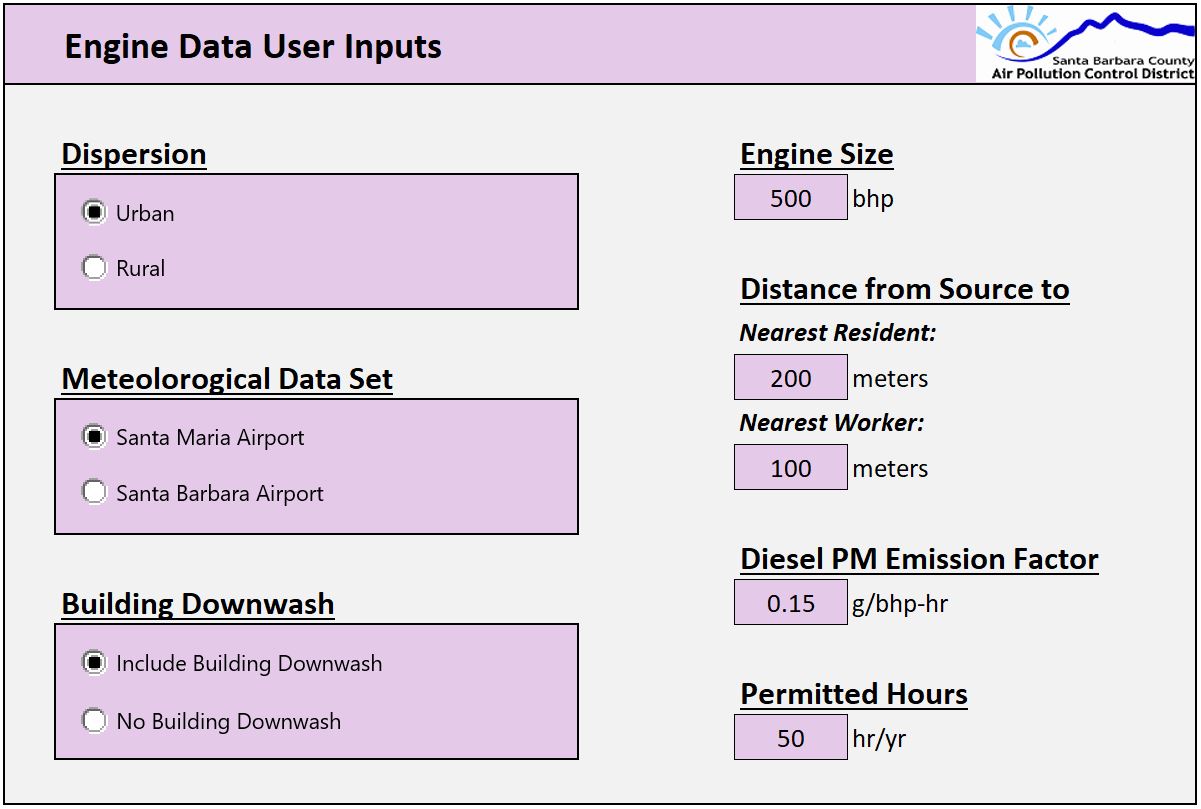Overview
The District has created a health risk assessment (HRA) screening tool spreadsheet for diesel-fired internal combustion engines (DICE), titled DICE Screening Tool.xlsx. This spreadsheet calculates conservative cancer risk and chronic non-cancer risk due to diesel particulate matter (PM) emissions from DICE. This tool was created to reduce the amount of time required to conduct HRAs for DICE permits. The District has also published a user guide for the tool.
The user must input the following information into the spreadsheet: dispersion type (urban or rural), appropriate meteorological data (Santa Maria Airport or Santa Barbara Airport), whether or not to include building downwash effects, engine size, distance from the engine to the nearest resident and nearest worker, the diesel PM emission factor, and maximum number of hours that the engine is permitted to operate in a year for non-emergency purposes. An example input table is shown below.

The DICE Screening Tool was created using a set of default stack parameters for DICE, multiple AERSCREEN runs and the Risk Assessment Standalone Tool of CARB’s HARP 2 software. More information about the methodology to develop this tool can be found in the District’s Background Document for DICE Screening Tool.
Acute and 8-Hour Chronic Non-Cancer Risk
Because diesel PM does not have an acute or 8-hour reference exposure level, the only way to calculate the acute or 8-hour risk for a DICE is to calculate the emissions of speciated pollutants in diesel exhaust. Because these speciated pollutants are components of diesel exhaust, their annual emissions are not used for cancer and chronic non-cancer risk determination, as this would overestimate the cancer and chronic non-cancer risk.
The available speciated pollutant emission factors for DICE are based on source testing performed on Tier 0 engines in the early 1990s. The USEPA emission standards for diesel engines have become much more stringent since this time. Therefore, these factors are not representative of Tier 3 and Tier 4 engines, and Tier 2 engines greater than 750 bhp. At this time, the District has not determined representative emission factors for newer engines. For this reason, the acute and 8-hour HIs are not required to be evaluated for new diesel engines. Once representative emission factors have been identified for newer engines, the DICE Screening Tool will be updated with those factors.
The District has created a version of the DICE Screening Tool that includes the acute non-cancer risk calculation for older diesel engines, which is available upon request. Very few pollutants have 8-hour reference exposure levels, which makes it unlikely that the 8-hour risk would be above the significant risk thresholds while the other risk types are below the thresholds. For that reason, this version of the tool does not include the 8-hour chronic non-cancer risk calculation.
Links to References
- The following memo describes the process to create a table of default DICE stack parameters: Finalized DICE Stack Parameters.
- The following spreadsheet contains the building information used in the AERSCREEN modeling runs for completing the DICE Screening Tool: DICE Screening Building Information.xlsx.
- The AERSURFACE output files used in the AERSCREEN modeling runs can be found in the table below:
| Meteorological Data Set | Year | AERSURFACE Output File |
| Santa Maria Airport | 2014 | SMX_2014_AERSURFACE.zip |
| Santa Barbara Airport | 2014 | SBA_2014_AERSURFACE.zip |
Other Information
- More information about diesel engines is available on the District’s Diesel Internal Combustion Engine (DICE) Air Toxic Control Measure webpage.
- Detailed requirements on performing health risk assessments are included in the District’s Modeling Guidelines for Health Risk Assessments, Form -15i.

